Wilhelm Hittorf (1824-1914)
Curriculum Vitae
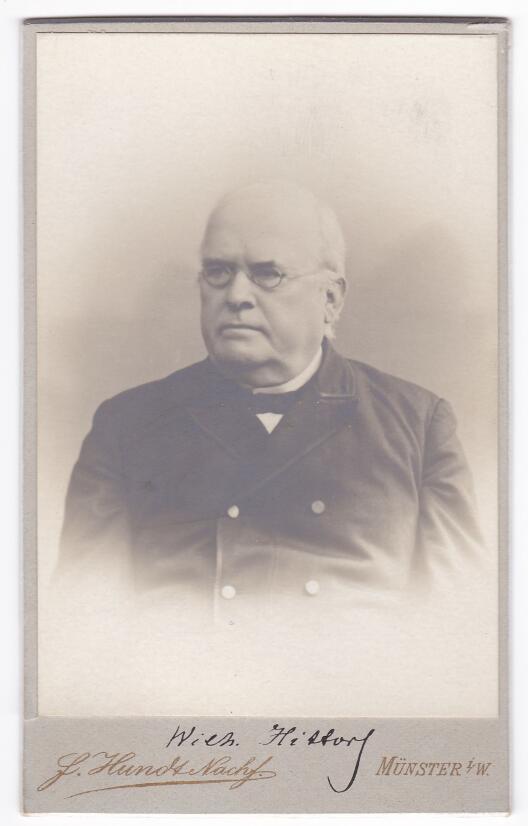
© CC BY-NC-SA | DRM/F. Hundt Nachfolger 27th March 1824: Born in Bonn
1842 - 1847: Studied mathematics and physics in Bonn and Berlin
1846: PhD in Bonn under Julius Plücker on conic sections
1847/48: Private lecturer for physics and chemistry in Münster
1852: Associate professor for physics and chemistry
19th August 1856: Full professor for physics and chemistry
1870/71: Rector
from 1877: Professor of physics after the establishment of an independent chair for chemistry
1888/89: Friedrich Paschen worked as an assistant for Hittorf
1889: Ceased teaching activities
28th November 1914: Died in Münster
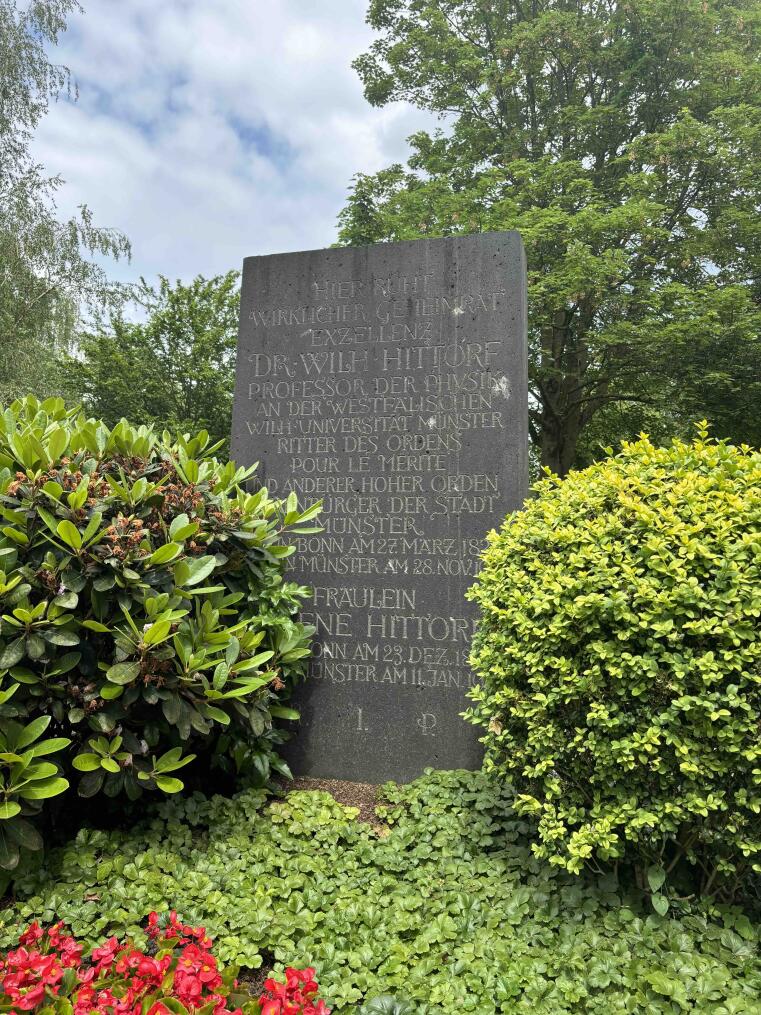
Hittorf's grave at the central cemetery in Münster, opposite the wall to the new section© Daniel Wigger Honors
1877: Knight of the Order of the Red Eagle, 4th Class
1884/85: Appointment as Privy Governmental Councillor
Corresponding member of the Royal Academy of Sciences in Berlin
1877: Knight of the Order of the Red Eagle, 3rd Class with Ribbon
1890/91: Corresponding member of the Royal Society of Sciences in Göttingen
Honorary member of the Physical Society in London
Honorary member of the Physical Society in Manchester
1896: Honorary membership in the German Electrochemical Society (later the Bunsen Society for Applied Physical Chemistry)
1896/97: Honorary member of the Physical Association in Frankfurt am Main
Foreign member of the Lower Rhine Society for Nature and Medicine in Bonn
Foreign member of the Royal Danish Society in Copenhagen
Corresponding member of the Royal Bavarian Academy of Sciences in Munich
1897: Knight of the Order "Pour le Mérite" for Sciences and Arts
1900: Honorary president of the German Electrochemical Society
Honorary member of the German Chemical Society in Berlin
Corresponding member of the Academy of Sciences in Paris
Honorary Doctor of the Medical Faculty of the University of Leipzig
1902: Corresponding member of the Botanical Society for Natural Sciences in Rotterdam
Corresponding member of the Society for the Advancement of Natural Sciences in Marburg
Honorary Doctor of the Faculty of Mathematics and Natural Sciences at the University of Strasbourg
Honorary Doctor of Engineering at the Technical University of Berlin
Honorary Doctor of Engineering at the Technical University of Hannover
1902/03: Knight of the Order of the Red Eagle, 2nd Class
1903: Recipient of the Hughes Medal from the Royal Society of London
(Hittorf had the medal melted down in November 1914, shortly before his death, and donated the proceeds of 300 marks to the Red Cross)
Foreign member of the Dutch Society of Sciences in Haarlem
Honorary member of the Finnish Society of Sciences in Helsinki
1905: Honorary membership of the Royal Academy of Sciences for the Public Good in Erfurt
1906: Foreign member of the Reale Accademia dei Lincei in Rome
1907/08: Knight of the Order of the Red Eagle, 2nd Class with Star
1914: Grant of Honorary Citizenship of the city of Münster

Excerpt from the staff directory of the University of Münster for the summer semester© CC PD | Universität Münster 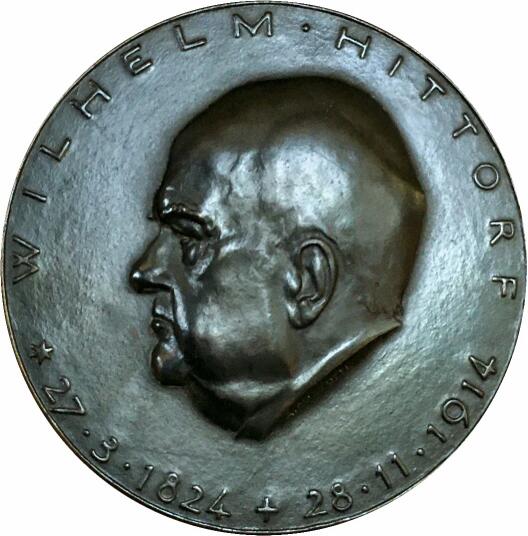
Hittorf Plaque | Passed on amongst his direct successors© Marcus Donath Direct successors of Wilhelm Hittorf:
1890-1900 Eduard Ketteler
1901-1908 Adolf Heydweiller
1908-1935 Gerhard C. Schmidt
1935-1949 Hermann Senftleben
1949-1973 Eugen Kappler
1973-1999 Alfred Benninghoven
seit 1999 Markus DonathThings named after Hittorf:
Crookes-Hittorf tube: Gas discharge tube with potential probes
See article 'Von Röhren und Strahlen: Kathodenstrahlen, Röntgenstrahlen, Uranstrahlen, Geißler-, Hittorf-, Crookesröhren' in Kultur und Technik Heft 1 (1988) (in German)
Hittorf dark room: Dark area near the cathode between the glow skin and negative glow light
Hittorfsche Überführungszahlen (ion transport number): Share of the ion current in the total current
Hittorf's metallic phosphorus: Violet-colored allotropy of phosphorus, belongs to the van der Waals materialsSchool:
Wilhelm-Hittorf-Gymnasium in Münster
Hittorf-Gymnasium in Recklinghausen
Streets:
There are Hittorfstraßen in Münster, Bonn, Köln, Essen, Remscheid, Burghausen and Berlin-Dahlem (at the Fritz Haber Institute) and the Johann-Hittorf-Straße in Berlin-Adlershof (at the Max Born Institute)Achievement
Publication list (A: Articles, B: Comments)
A.1 „Ableitung einiger Eigenschaften der Kegelschnitte aus ihrer Polargleichung“ Crelles Journ. 38, 89-92 (1847) Extraction of the Dissertation
A.2 „Ueber die Bildung einer blauen Oxydationsstufe des Platins, so wie einiger anderer Oxyde der edlen Metalle auf galvanischem Wege“ Pogg. Ann. 72 (11), 481-485 (1847) [today: Ann. d. Phys. 148 (11), 481-485 (1847)]
A.3 „Ueber das elektrische Leitungsvermögen des Schwefelsilbers und Halbschwefelkupfers“ Pogg. Ann. 84 (9), 1-28 (1851) [today: Ann. d. Phys. 160 (9), 1-28 (1851)]
A.4 „Ueber die Allotropie des Selens“ Pogg. Ann. 84 (10), 214-220 (1851) [today: Ann. d. Phys. 160 (10), 214-220 (1851)]
A.5.1 „Ueber die Wanderungen der Ionen während der Elektrolyse, Erste Mittheilung“ Pogg. Ann. 89 (6), 177-211 (1853) [today: Ann. d. Phys. 165 (6), 177-211 (1853)]
A.5.2 „Ueber die Wanderungen der Ionen während der Elektrolyse, Zweite Mittheilung“ Pogg. Ann. 98 (5), 1-33 (1856) [today: Ann. d. Phys. 174 (5), 1-33 (1856)]
A.5.3 „Ueber die Wanderungen der Ionen während der Elektrolyse, Dritte Mittheilung“ Pogg. Ann. 106 (3), 337-411 (1859) [today: Ann. d. Phys. 182 (3), 337-411 (1859)]
A.5.4 „Ueber die Wanderungen der Ionen während der Elektrolyse (Schluß)“ Pogg. Ann. 106 (4), 513-586 (1859) [today: Ann. d. Phys. 182 (4), 513-586 (1859)]
A.5.a „Rechtfertigung seiner Mittheilungen „Ueber die Wanderungen der Ionen“. Elektrolyse einer Lösung zweier Salze“ Pogg. Ann. 103 (1), 1-56 (1858) [today: Ann. d. Phys. 179 (1), 1-56 (1858)]
A.5.b „Rechtfertigung des Satzes: „Electrolyte sind Salze“ als Erwiderung auf Dr. L. Bleekrode’s Kritik“ Wied. Ann. 4 (7), 374-416 (1878) [today: Ann. d. Phys. 240 (7), 374-416 (1878)]
A.5 also published in in Ostwalds Klassikern der exakten Wissenschaften No. 21 and No. 23 (1891)
A.6.0 J. Plücker & W. Hittorf, „Neue Untersuchungen über die Spektralanalyse“ Verh. d. naturh. Ver. d. Rheinl. 20, 39-42 und 89-92 (1863)
A.6 J. W. Hittorf & J. Plücker „On the spectra of ignited gases and vapours, with especial regard to the different spectra of the same elementary gaseous substance“ Phil. Trans. 155, 1-29 (1865)
A.7 „Zur Kenntniß des Phosphors“ Pogg. Ann. 126 (10), 193-227 (1865) [today: Ann. d. Phys. 202 (10), 193-227 (1865)]
A.8.1 „Ueber die Elektricitätsleitung der Gase, Erste Mittheilung“ Pogg. Ann. 136 (1), 1-31 (1869) [today: Ann. d. Phys. 212 (1), 1-31 (1869)]
A.8.1.1 „Ueber die Elektricitätsleitung der Gase, Erste Mittheilung (Schluß)“ Pogg. Ann. 136 (2), 197-234 (1869) [today: Ann. d. Phys. 212 (2), 197-234 (1869)]
A.8.2 „Ueber die Elektricitätsleitung der Gase, Zweite Mittheilung“ Pogg. Ann. Jubel-Bd. 430-445 (1874)
A.8.3 „Ueber die Elektricitätsleitung der Gase, Dritte Mittheilung “Wied. Ann. 7 (8), 553-631 (1879) [today: Ann. d. Phys. 243 (8), 553-631 (1879)]
A.8.4.1 „Ueber die Elektricitätsleitung der Gase, Vierte Mittheilung“ Wied. Ann. 20 (12), 705-755 (1883) [today: Ann. d. Phys. 256 (12), 705-755 (1883)]
A.8.4.2 „Ueber die Elektricitätsleitung der Gase, Vierte Mittheilung (Fortsetzung)“ Wied. Ann. 21 (1), 90-139 (1884) [today: Ann. d. Phys. 257 (1), 90-139 (1884)]
A.8.a „Berichtigung zu dem Aufsatz: Ueber die Elektricitätsleitung der Gase“ Wied. Ann. 8 (12), 671 (1879) [today: Ann. d. Phys. 244 (12), 671 (1879)]
A.9 „Zur Kenntnis der elektromotorischen Kräfte galvanischer Kombinationen“ Z. Phys. Chem. 10, 593-620 (1892)
A.10 W. Hittorf & H. Salkowski „Ueber die merkwürdige Klasse unorganischer Säuren und ihr elektrolytisches Verhalten“ Z. Phys. Chem. 28, 546-555 (1899)
A.11.1 „Ueber das electrochemische Verhalten des Chroms, Erste Mitteilung“ Z. Phys. Chem. 25, 729-749 (1898)
A.11.2 „Ueber das electrochemische Verhalten des Chroms, Zweite Mitteilung“ Z. Phys. Chem. 30, 481-507 (1899)
A.11 auch erschienen in:
Berl. Ber. 14, 193-212 (1898)
Wied. Ann. 65 (6), 320-343 (1898) [today: Ann. d. Phys. 301 (6), 320-343 (1898)]
A.12 „Über die Passivität der Metalle“ Z. Phys. Chem. 34, 385-402 (1900)
A.13 „Bemerkung über die Bestimmung der Überführungszahlen der Ionen während der Elektrolyse ihrer Lösungen. Das Verhalten der Diaphragmen bei derselben“ Z. Phys. Chem. 39, 613-629 (1902)
A.14 „Das Verhalten der Diaphragmen bei der Elektrolyse von Salzlösungen, Zweite Mitteilung“ Z. Phys. Chem. 43, 239-249 (1903)
B.1 „Bemerkungen zu dem Aufsatz von W. Siemens: Ueber das Leuchten der Flamme“ Wied. Ann. 19 (5), 73-77 (1883) [today: Ann. d. Phys., 255 (5), 73-77 (1883)]
B.2 „Bemerkungen zum Aufsatz der Herren Nernst und Riesenfeld: Ueber electrolytische Erscheinungen an der Grenzfläche zweier Lösungsmittel“ Ann. d. Phys. 9, 243-245 (1902) [today: Ann. d. Phys. 314 (9), 243-245 (1902)]
Epitaphs
From the Chronicals of the University 1914/15
In the winter semester of 1914/15, the University suffered a tremendous loss. On 28th November 1914, after a brief illness, His Excellency, the Actual Privy Councillor Dr. Wilhelm Hittorf, ordinary professor of physics at our Westphalian Wilhelms University, Knight of the Order Pour le Mérite for Sciences and Arts as well as other high orders, honorary doctor of the Universities of Leipzig and Strasbourg and the Technical Universities of Berlin and Hanover, member of many academies and scholarly societies, and honorary citizen of the city of Münster passed away aged 90. In honor of the deceased, an academic memorial ceremony was held on 2nd December in the University auditorium, attended by representatives from the Technical Universities of Hanover and Charlottenburg, the faculty, His Highness the University Curator and his deputy, representatives of the administrative authorities, the student body, and members of the Hittorf family. Rector Prof. Dr. Mausbach and the successor in the physics department, Prof. Dr. Schmidt, dedicated words full of deep emotion and high recognition to the departed. Following the moving ceremony, the deceased was transferred to the central cemetery, where a church burial took place in a special crypt.
Wilhelm Hittorf was born on 27th March 1824, in Bonn; after attending the local Gymnasium, he studied Mathematics and Physics in Bonn and Berlin from 1842 to 1847. At the former University, he was awarded a doctorate on 21st December 1846. In 1848, he was called by the ministry to Münster to teach physics and chemistry at the former Academy there. On 12th January 1852, he was appointed Associate Professor and on 19th August 1856, after declining a call for a full professorship in Bern, he was appointed Full Professor. For 32 years he represented both subjects until, in 1877, a separate professorship for chemistry was established. He then continued to hold the professorship for physics, which he relinquished at the end of the summer semester of 1889 due to a nervous condition, seeking healing in a sanatorium.
Although, the external events in Hittorf’s many years are few. However, his scientific life has been all the richer. His greatness lay not in the number of questions he tackled, but in his keen sense for selecting meaningful problems, his even mastery of both the chemical and the physical sides, his exceptionally careful and reliable conduct of his undertakings, and his unique perspectives, which, often in sharp contrast to the prevailing views at the time, eventually penetrated and prevailed. It is also noteworthy that Hittorf had to work under very unfavorable external conditions. For his lectures and experimental investigations, he was allocated only 50 thalers, a sum whose insignificance anyone can assess considering that today the budget for physics at any secondary school is at least four times as much. Requests for increases were denied because the Provincial College of Education had established the principle that the lecturer at the small local academy was not tasked with promoting science through extensive and expensive experiments. Hittorf thought otherwise, and despite the adverse conditions, he carried out his scientific work with great personal sacrifice and tireless diligence. Through this, he ultimately achieved recognition for the small physics cabinet at the academy as being equal to the better-endowed major institutes at universities.
Hittorf’s work has become common property of physicists. There is no physics textbook that does not discuss his great discoveries. In the early 1850s, he was the first to clarify the processes that occur when electric current passes through liquids. Although objections were raised against the experimental results, his work was initially rejected, mainly because they seemed to threaten secure scientific knowledge at the time. It was not until Kohlrausch in Würzburg reached the same results by different means 20 years later and later Ostwald and Arrhenius showed that important laws could be derived from Hittorf's theoretical views, that it was recognized the injustice done to the scholar from Münster by the rejection and disregard of his work. Since then, Hittorf's views have been increasingly recognized as fruitful. They form a cornerstone of the great edifice of electrochemistry.
Likewise, his other great discovery, that of cathode rays, was initially rejected by the scientific community. These are rays emitted by metals in rarefied gases under the influence of high-voltage electrical currents. Hittorf discovered them in 1869 and recognized all their properties, but it was only when Crookes rediscovered them five years later that the discovery was celebrated, and today the English, who are known to claim everything for themselves regardless of whether it belongs to them or not, call them "Crookes rays". They form the basis for Roentgen's discovery.
These two works form the pinnacle of Hittorf's scientific investigations. In addition, he has published a larger number of works from all parts of physics and chemistry, all showing his sharp intellect and meticulousness in experimentation. Technology has also greatly benefited from these works.
The value of his discoveries was recognized by the scientific community belatedly but then fully. He is a member of almost all science academies; the highest orders adorn him, and when he celebrated his 90th birthday in the spring of 1914, the Ministry of Culture honored him with the title of Excellency.
Hittorf also made great contributions to the university. Because our institution is still young, it cannot, like its older sisters, point to a larger number of men whose significance is recognized worldwide. But it does have one, whose name is mentioned with equal respect everywhere, and that is Hittorf. He made the academy famous.
In another respect, he has earned great merits for the university. As mentioned earlier, he suffered from the small means available to him for his scientific research. To make work easier for his colleagues and students, he donated a larger capital, the interest from which is used annually for enterprises in the field of natural sciences. Many works have been made possible through this.
Finally, one must also remember his merits in the development of the academy into a full university. He was one of the first to advocate for this with advice and action; he pushed through the establishment of separate institutes for natural sciences. Following his suggestion, the chemical institute was built.
The city of Münster is intimately connected with its university; the flourishing of the university also benefits the city. Thus, by dedicating his entire strength to the expansion of the academy, Hittorf also earned merit for the city. This was recognized by the city by appointing him an honorary citizen as a sign of gratitude.
A great man has departed from us, a man about whom one can say without exaggeration: the trace of his earthly days will not perish in aeons. He has left us a precious legacy, his example and his work. And while deep sadness fills us at his departure, it is overshadowed by gratitude for his work for science and his university. The seed he sowed will never perish but will bear fruit a thousandfold. Thus, the name Hittorf will always be recorded in glowing letters in the annals of our university.
(From an article by Prof. Dr. Gerhard Schmidt.)The heirs of Hittorf donate to the university the plaster bust of the deceased, as well as a series of valuable mementos (certificates, addresses, medals) and his scientific library; also, for the lecturer's room, a portrait of Hittorf, for which the heartfelt thanks of the university are also extended here.
Chronik der Westfälischen Wilhelms-Universität zu Münster für das Jahr vom 1. April bis 31. März 1915
URN urn:nbn:de:hbz:6:1-347912
WeblinkFurther Epitaphs
Bayerischen Akademie der Wissenschaften from Arnold Sommerfeld
Nature 94, 484 (1914) from J. C. P.
Zeitschrift für angewandte Chemie 27, 657-658 (1914) from Hans Goldschmidt
Z. f. Elektrochem. 21(5/6), 65-69 (1915) from Svante Arrhenius
Die Naturwissenschaften 3(4), 7 (1915) from Alfred Coehn
Physikalische Blätter 4(2), 64-68 (1948) from Gerhard C. Schmidt
Physikalische Blätter 20(12), 571-577 (1964) from Hans Schimank
Brief chronicle of the department
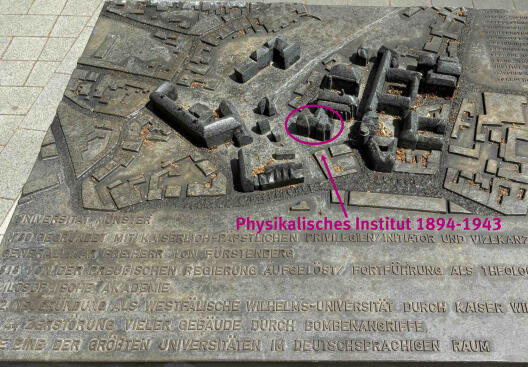
1879: Creation of a professorship for chemistry
Since then, Hittorf has held an independent professorship for physics.
1920: The second physics professorship is converted into a personal chair for theoretical physics.
Erwin Madelung briefly held this position, and from 1922, Adolf Kratzer held this professorship.
1943: The institute building is completely destroyed.
1944: The Physical Institute moves to Holzminden.
1945: The institute returns to Münster, housed in various temporary accommodations.
The newly founded Institute for Theoretical Physics is located in the palace.
1952: The Institute for Applied Physics is founded, located at Schlossplatz 5, Heinz Bittel becomes the first professor.
1953: The Physical Institute moves to the former Upper Presidency at Schlossplatz 7.
1959: The Institute for Nuclear Physics is founded, located on Tibusstr., E. Huster is the first professor.
1966: The Institute for Theoretical Metal Physics is founded, O. Krisement is the first professor.
The Institute for Applied Physics moves into a new building at the Science Center.
1970: The Faculty of Mathematics and Natural Sciences is dissolved, and the Department of Physics is established.
Astronomical Institute (led by H. Straßl since 1958)
Institute for Geophysics (led by B. Brockamp since 1959)
Institute for Metal Research (led by Th. Heumann since 1959)
become parts of the department.
1972: The Institute for Nuclear Physics moves into a new building at the Science Center.
1980: The remaining institutes move into a new building at the Science Center.
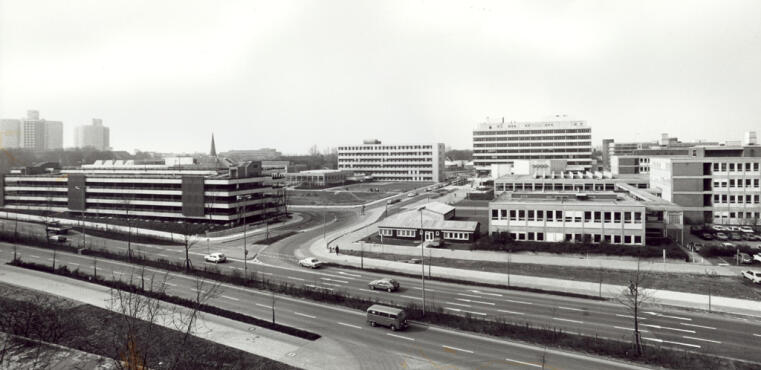
During National Socialism
from Achim Weiguny
Die Physik an der Universität Münster im Spannungsfeld des Nationalsozialismus
Published in:
Reconstruction in the post-war period
Biography of Adolf Kratzer by Norbert Schmitz
Published in:
Wissenschaftliche Schriften der Universität Münster / Reihe XIV, Bd. 1

